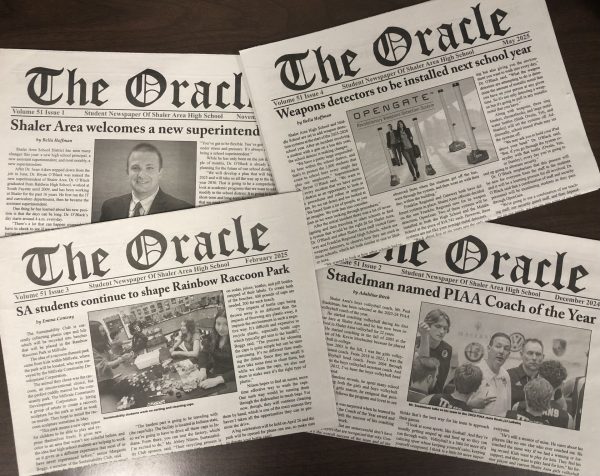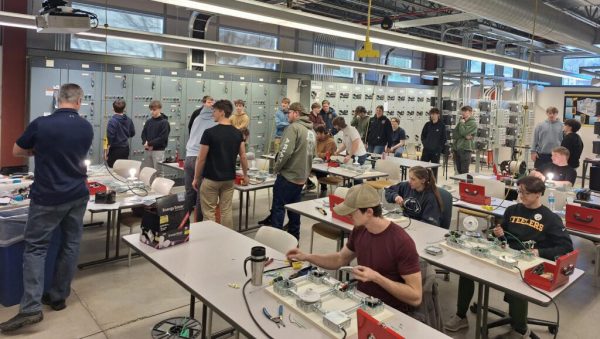Shaler Area prepares for shift to hybrid learning
Students make their way to the main entrance at Shaler Area High School.
While Hampton, Fox Chapel, North Allegheny, and other districts around Shaler Area are weeks into hybrid learning, Shaler Area students and teachers are sitting at home staring at iPad and computer screens, navigating the 100 percent virtual learning model. However, that will change on October 12, when Shaler transitions to a hybrid system.
Generally, students with last names A-K will attend school in-person on Monday and Tuesday, while students with last names L-Z will go Thursday and Friday, with some exceptions. Students will engage in virtual learning on the three weekdays they are not in the building. The main objective of the hybrid system is to limit the amount of students in the building at one time while still allowing for in-person instruction.
Originally, Shaler Area planned to start the year with the hybrid model, but just three weeks before the school year was scheduled to begin, the district announced it would be delaying the start of school until after Labor Day and beginning the year 100 percent virtually.
Shaler Area superintendent Mr. Sean Aiken said that the change in plans resulted from concern about how safely the hybrid system could be implemented. The decision to commit to the hybrid model was made in July, but as the beginning of the year drew nearer, the school board did not feel comfortable with sending 4,200 students and almost 500 staff members into the buildings with the number of COVID-19 cases in Allegheny County.
“The more we talked to the Allegheny County Health Department and tried to take in information and work with other school districts, we just didn’t feel like it was the right thing to do,” Mr. Aiken said. “But, the entire time we pivoted to that decision, we still kept our eyes on this October 12th date, because our goal is to get back into school, not just in hybrid, but to get back five days traditional.”
However, before Shaler Area can think about a five day learning model, the district must make the transition into hybrid learning, a transition Mr. Aiken expects to be “a significant challenge.”
“Hybrid is hard,” he said. “I don’t think people can live in hybrid for a long time.”
If students opt to transition to the hybrid system, they will have to juggle going to school in-person while obeying safety measures like wearing masks and social-distancing, as well as continuing virtual learning three days a week. Although the hybrid model will be an adjustment, students participating are glad to have an opportunity to be back in school.
“I decided to go hybrid because learning from home was hard for me,” junior Catherine Clark said. “I felt like I was always distracted and the social isolation was hard.”
Some students have chosen to continue in the 100 percent virtual model instead of switching to hybrid learning due to safety concerns or the added flexibility of learning online.
“I would love to go back to school in person as much as the next guy, but the risks from hybrid learning are way too high just for a slice of so-called ‘normalcy’,” junior Mai Swendsen said. “If the 100 percent virtual option gives me a 100 percent chance to avoid potentially bringing the virus home and potentially exposing and killing the ones I love, then I will pick it every time.”
Teachers will also have to take on the difficult task of shifting their teaching methods to accommodate their in-person and virtual learners. While some of their students will be in the classroom, some will be online, tuning into the day’s lesson through Google Meet.
Mrs. Mindy Thiel, AP European History teacher, said that although she is anxious about possible technology issues, she is looking forward to teaching students in her physical classroom again.
“I’m nervous, but I’m more excited than nervous,” she said. “I want to do a good job not only the people in front of me, but the people who are going to be behind the screen.”
The school district hopes the transition will go as smoothly as possible, but Mr. Aiken admitted there is a chance that the district could move back to a 100 percent virtual model if many students begin testing positive for COVID-19.
West Allegheny and McKeesport, two districts in Allegheny County who are using the traditional five days a week model, have seen promising results. According to Mr. Aiken, although the transition has been challenging, superintendents in both districts “insist everything is going well” and would not do anything differently. Mr. Aiken added that he was “encouraged” by what those superintendents said.
No matter what model is utilized, Mr. Aiken noted that the key is adopting the right attitude to make the best of the situation.
“You can find a problem with hybrid, you can find a problem with five day, you can find a problem with virtual. We need to say we are going to figure it out,” Mr. Aiken said. “There’s always people in life who like to find problems. We like to find people who find solutions. The people who are successful are the people who find a way.”
As students prepare for the transition to the hybrid model, Shaler Area staff are being counted on to find a way to give students the best education possible in this unprecedented time.

Hi, I’m Maggie. I collect business cards and I can’t wait for the next Ford Truck Month! My favorite word is ubiquitous. This is my first year on newspaper...







